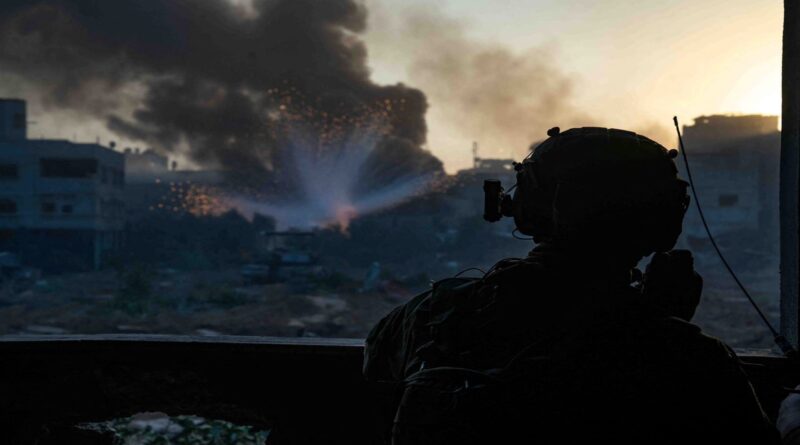Airstrikes hit camps in central Gaza as Biden administration approves new weapons sales to Israel
[ad_1]
An Israeli soldier operates in the Gaza Strip amid the ongoing conflict between Israel and the Palestinian Islamist group Hamas, in this handout picture released on Dec. 29, 2023.
Israel Defense Forces | Via Reuters
Israeli warplanes struck two urban refugee camps in central Gaza on Saturday, as the Biden administration approved a new emergency weapons sale to Israel despite persistent international cease-fire calls over mounting civilian deaths, hunger and mass displacement in the enclave.
Even a brief halt in fighting seems out of reach. A senior Hamas official told The Associated Press in Beirut on Saturday that the group has not budged from its position that a permanent cease-fire has to be the starting point for any further releases of Israeli and foreign hostages the group holds, which runs counter to a recent proposal by Egypt for a staged end to the war.
It’s a demand Israel is bound to reject. Israel has said it will pursue its unprecedented air and ground offensive until it has dismantled Hamas, a goal viewed by some as unattainable because of the militant group’s deep roots in Palestinian society. The United States has shielded Israel diplomatically and has continued to supply weapons.
Israel argues that ending the war now would mean victory for Hamas, a stance shared by the Biden administration which at the same time urged Israel to do more to avoid harm to Palestinian civilians.
The war, triggered by the deadly Oct. 7 Hamas attack on southern Israel, has displaced some 85% of the Gaza Strip’s 2.3 million residents, sending swells of people seeking shelter in Israeli-designated safe areas that the military has nevertheless also bombed. That has left Palestinians with a harrowing sense that nowhere is safe in the tiny enclave.
Read more about the Israel-Hamas war:
The Health Ministry in Gaza said Saturday that the Palestinian death toll since the start of the war rose to 21,672, with a further 56,165 people wounded during the same period. Over the past 24 hours, 165 people were killed, said ministry spokesman Ashraf al-Qidra. The ministry does not distinguish between the deaths of combatants and civilians, but has said about 70% of those killed have been women and children.
Some of the latest deaths were reported as Israeli airstrikes targeted the urban refugee camps of Nuseirat and Bureij overnight and into Saturday.
Nuseirat resident Mustafa Abu Wawee said a strike hit the home of one of his relatives, killing two people.
“The (Israeli) occupation is doing everything to force people to leave,” he said over the phone while searching along with others for four people missing under the rubble. “They want to break our spirit and will but they will fail. We are here to stay.”
A second strike late Friday in Nuseirat targeted the home of a journalist for Al-Quds TV, a channel linked to the group Islamic Jihad whose militants also participated in the Oct. 7 attack. The channel said the journalist, Jaber Abu Hadros and six members of his family were killed.
Bureij resident Rami Abu Mosab said sounds of gunfire echoed across the camp overnight, followed by heavy airstrikes Saturday.
With Israeli forces pushing deeper into Khan Younis and the camps of central Gaza, tens of thousands of Palestinians streamed into the already crowded city of Rafah at the southernmost end of Gaza in recent days.
Drone footage showed a vast camp of thousands of tents and makeshift shacks set up on what had been empty land on Rafah’s western outskirts next to U.N. warehouses. People arrived in Rafah in trucks, in carts and on foot. Those who did not find space in the already overwhelmed shelters put up tents on roadsides slick with mud from winter rains.
More U.S. weapons for Israel
The State Department said Friday that Secretary of State Antony Blinken told Congress he approved a $147.5 million sale for equipment, including fuses, charges and primers, that is needed for 155 mm shells Israel bought previously.
It marked the second time this month that the Biden administration is bypassing Congress to approve an emergency weapons sale to Israel. The department cited the “urgency of Israel’s defensive needs” as a reason for the approval.
Blinken made a similar decision on Dec. 9 to approve the sale to Israel of nearly 14,000 rounds of tank ammunition worth more than $106 million.
Both moves have come as President Joe Biden’s request for a nearly $106 billion aid package for Ukraine, Israel and other national security needs remains stalled in Congress, caught up in a debate over U.S. immigration policy and border security. Some Democratic lawmakers have spoken of making the proposed $14.3 billion in American assistance to its Mideast ally contingent on concrete steps by Israeli Prime Minister Benjamin Netanyahu’s government to reduce civilian casualties in Gaza during the war with Hamas.
Difficulties in delivering aid
More than a week after a U.N. Security Council resolution called for the unhindered delivery of aid at scale across besieged Gaza, conditions have only worsened, U.N. agencies warned.
Aid officials said the aid entering Gaza remains woefully inadequate. Distributing goods is hampered by long delays at two border crossings, ongoing fighting, Israeli airstrikes, repeated cuts in internet and phone services and a breakdown of law and order that makes it difficult to secure aid convoys, they said.
Nearly the entire population is fully dependent on outside humanitarian aid, said Philippe Lazzarini, head of UNRWA, the U.N. agency for Palestinian refugees. A quarter of the population is starving because too few trucks enter with food, medicine, fuel and other supplies — sometimes fewer than 100 trucks a day, according to U.N. daily reports.
U.N. monitors said operations at the Israeli-run Kerem Shalom crossing halted for four days this week because of security incidents, such as a drone strike and the seizing of aid by desperate Gaza residents.
They said the crossing reopened Friday, and that a total of 81 aid trucks entered Gaza through Kerem Shalom and the Rafah crossing on the Egyptian border — a fraction of the typical prewar volume of 500 trucks a day.
Trading for hostages
Israeli officials, meanwhile, have vowed to bring back more than 100 hostages still held in Gaza, after militants seized more than 240 in the Oct. 7 assault that also killed some 1,200 people, mostly civilians.
The military says 168 of its soldiers have been killed since the ground offensive began.
Mediator Egypt has proposed a multi-stage plan that would kick off with a swap of hostages for prisoners, accompanied by a temporary cease-fire — along the lines of an exchange during a weeklong truce in November.
In a subsequent phase, talks would begin on forming a transitional Palestinian government of experts who would run both Gaza and the Israeli-occupied West Bank.
Israel and Hamas remain far apart on the terms of a cease-fire and future swaps.
“We have been clear that a complete cease-fire is the first step,” Osama Hamdan, a senior Hamas official in Beirut, said Saturday. It’s a position that seemingly derails the Egyptian plan, though Hamdan also said conversations are continuing.
“There are also ideas we have received through our brothers in Qatar, and we have not given any final answer so far,” he said. “This may take some time. We are keen to talk about the details, because the idea put forward today may develop in different ways and may no longer be raised at all.”
[ad_2]




